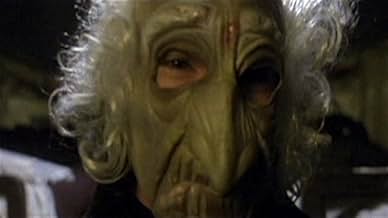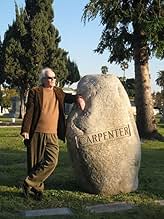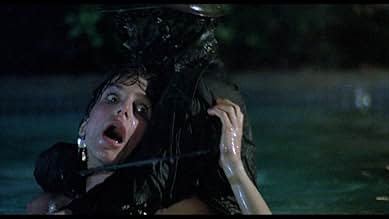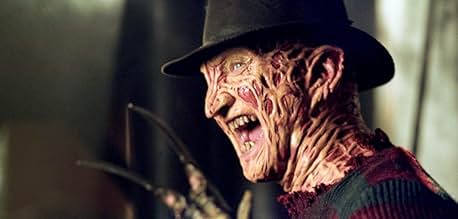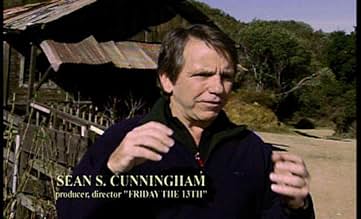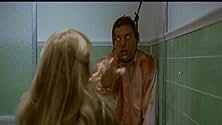VALUTAZIONE IMDb
7,2/10
3714
LA TUA VALUTAZIONE
Aggiungi una trama nella tua linguaA documentary on the history of the slasher film.A documentary on the history of the slasher film.A documentary on the history of the slasher film.
- Regia
- Sceneggiatura
- Star
Amy Holden Jones
- Self
- (as Amy Holden-Jones)
Anthony Timpone
- Self
- (as Tony Timpone)
Recensioni in evidenza
10kirk-246
I am probably one of the biggest fans of slasher movies.Whenever I see one,I expect gore,violence,and mayhem.'Going to Pieces: The Rise of the slasher Film' delivers what I want.It shows us when the slasher genre was famous after such films such as 'Psycho', 'Halloween', and 'Scream'.It also shows us when the genre was becoming weak after films such as 'The Texas Chainsaw Massacre: The Next Generation' and many others.What really made the movie good was showing us some clips and death scenes of the films of the slasher genre,which makes this documentary both gory and entertaining.I just have one question before my review ends.
Where is the DVD?
Where is the DVD?
I'm a little impressed. Whether the credit belongs to director Jeff McQueen, producers Rachel Belofsky and Rudy Scalese, or the writers, this is a more meaningful, thoughtful documentary than I supposed it was going to be. I'm not saying that it's perfect, because there are embellishments here and there (music cues, title cards) that are a bit gauche, and the enthusiasm and anecdotes that some interviewees share are a bit much at times. Then again, that enthusiasm really speaks to how much fun everyone had making these movies, the passion they have for the underlying craft, and the thrill of the visceral storytelling. The feature earnestly covers a lot of ground: the violent thrillers from which slashers took influence; the art of illusion behind practical effects like blood and gore; discussion of where slashers fit into society and culture, and how they may or may not reflect that society and culture; the push to make movies that exploited every possible holiday and occasion, and every possible weapon of choice; and more. From producers and directors to effects artists and stars, we're greeted with a slew of interview subjects who offer their own perspective on the genre, with focus primarily on the golden age of the slasher from their inauguration with John Carpenter's 'Halloween' in 1978, to the early and mid 80s when slashers had more or less become the new "it" girl of horror. There is nothing in 'Going to pieces' that's a particular revelation, yet the picture gives welcome, broad perspective - or rather, retrospective - that's more sincere and ruminative than I'd have guessed before I sat to watch.
Some films get more emphasis than others, and not unreasonably; 'Halloween' began it all, 'Friday the 13th' raised the bar with crimson and viscera, and 'A nightmare on Elm Street' took things in a wild new direction. If only in passing, though, this touches upon even more flicks than I've seen, and some I'd never even heard of. Along the way, there's an early spotlight on the conventions that largely define slashers, including settings, protagonists, antagonists, murder weapons, and more - and with this in mind, one place where I think the title falters is in failing to identify how easily the genre became very formulaic, and very stale, very quickly. True, there are still many viewers who flock to slashers for the cavalcade of random violence and death, but I think there came a point where slashers became dull unless there is either some major point of brilliance to help it stand out, or some new twist on the style (e.g., 2015's 'The final girls') that really upended norms. In some measure 'The rise and fall of the slasher film' also raises reasonable questions: of what specifically defines the "slasher"; if every piece mentioned herein really is a slasher or just falls into "horror" generally, or some other subgenre; the extent to which slashers may have had influence elsewhere in horror; and ultimately how accurate the name even is, if slashers continue to be a major force in horror cinema. The documentary really does cover a lot of ground, but it could have broadened its scope even more, and despite the name it's worth observing that there's not so much a central thesis here as an overarching idea of examining the genre.
There are notions touched upon in passing that could have been explored even more deeply: the regressive, conservative values that seemingly inform killers in movies; the triumph of "the final girl" as a representation of feminism; the outdated, harmful language and ideas that "other" and demonize a subset of the population by setting up a particular type of figure as the killer (i.e., lots of ableism, homophobia, and transphobia); and so on. In fairness, to whatever extent 'Going to pieces' could have done more, maybe these were also beyond its purview, for the chief intent here was in a sort of history of the genre (as of 2006), and if imperfectly, I think it does that job very well. Whether one is a fan of slashers, or of documentaries, or just an avid cinephile at large, I think there's much to appreciate here for a lot of folks. All told it may not be something one needs to go out of their way to see, but for something light yet interesting, 'Going to pieces' is a fine movie that's well worth checking out if you have the chance.
Some films get more emphasis than others, and not unreasonably; 'Halloween' began it all, 'Friday the 13th' raised the bar with crimson and viscera, and 'A nightmare on Elm Street' took things in a wild new direction. If only in passing, though, this touches upon even more flicks than I've seen, and some I'd never even heard of. Along the way, there's an early spotlight on the conventions that largely define slashers, including settings, protagonists, antagonists, murder weapons, and more - and with this in mind, one place where I think the title falters is in failing to identify how easily the genre became very formulaic, and very stale, very quickly. True, there are still many viewers who flock to slashers for the cavalcade of random violence and death, but I think there came a point where slashers became dull unless there is either some major point of brilliance to help it stand out, or some new twist on the style (e.g., 2015's 'The final girls') that really upended norms. In some measure 'The rise and fall of the slasher film' also raises reasonable questions: of what specifically defines the "slasher"; if every piece mentioned herein really is a slasher or just falls into "horror" generally, or some other subgenre; the extent to which slashers may have had influence elsewhere in horror; and ultimately how accurate the name even is, if slashers continue to be a major force in horror cinema. The documentary really does cover a lot of ground, but it could have broadened its scope even more, and despite the name it's worth observing that there's not so much a central thesis here as an overarching idea of examining the genre.
There are notions touched upon in passing that could have been explored even more deeply: the regressive, conservative values that seemingly inform killers in movies; the triumph of "the final girl" as a representation of feminism; the outdated, harmful language and ideas that "other" and demonize a subset of the population by setting up a particular type of figure as the killer (i.e., lots of ableism, homophobia, and transphobia); and so on. In fairness, to whatever extent 'Going to pieces' could have done more, maybe these were also beyond its purview, for the chief intent here was in a sort of history of the genre (as of 2006), and if imperfectly, I think it does that job very well. Whether one is a fan of slashers, or of documentaries, or just an avid cinephile at large, I think there's much to appreciate here for a lot of folks. All told it may not be something one needs to go out of their way to see, but for something light yet interesting, 'Going to pieces' is a fine movie that's well worth checking out if you have the chance.
This is a pretty good treatment of the thinking that went on behind the scenes of movies like "Prom Night", "Friday the 13th", "Nightmare on Elm Street", "Texas Chainsaw Massacre", and others. The great thing is that the cool stories and insights are told by the key players involved (directors, producers, special effects artists). You get to hear not only their thoughts on the psychology involved, but also about the marketing struggles they had to deal with.
Essentially, this is a documentary which interweaves present-day interviews with film clips from classic 80's horror flicks to give you a behind the scenes look at a genre during its peak period of interest. If you're a horror fan, you'll probably like watching this.
Essentially, this is a documentary which interweaves present-day interviews with film clips from classic 80's horror flicks to give you a behind the scenes look at a genre during its peak period of interest. If you're a horror fan, you'll probably like watching this.
This is an interesting and pretty thorough documentary on the slasher film. It's not as good as reading a book on the subject, of course (there are several now, and this documentary is based on one of the better ones), but you get lots of films clips, and some interviews, not only with the usual horror convention attendees like Tom Savini and Felissa Rose,but also with more obscure characters like the Rabbi Herbert Freed who directed the obscure slasher "Graduation Day" (before he was a rabbi, of course).
What's most interesting for someone like me who is old enough to remember the first wave of slasher movies, is to recall how alarmed adults were at the time by these movies, which look like pretty harmless fun now. I especially remember the way they actually picketed "Silent Night, Deadly Night" because they were upset by the idea of an axe-murdering Santa Claus (in an ideal world these kind of idiots would be met with tear gas and police batons, just like anti-war protesters--who often have a legitimate reason for being upset--often are).
It's also ironic how widely available, thanks to DVD, uncut versions of these movies are today, considering how they were hacked up by American censors back then or outright banned over in Britain. It's probably just as stupid to get worked up about movies like "Hostel" or "Captivity" like people do nowadays. Remember the famous ad-line to "Last House on the Left" (one movie this doc barely mentions, although I guess it isn't really a slasher). "It's only a movie... It's only a movie. . .
What's most interesting for someone like me who is old enough to remember the first wave of slasher movies, is to recall how alarmed adults were at the time by these movies, which look like pretty harmless fun now. I especially remember the way they actually picketed "Silent Night, Deadly Night" because they were upset by the idea of an axe-murdering Santa Claus (in an ideal world these kind of idiots would be met with tear gas and police batons, just like anti-war protesters--who often have a legitimate reason for being upset--often are).
It's also ironic how widely available, thanks to DVD, uncut versions of these movies are today, considering how they were hacked up by American censors back then or outright banned over in Britain. It's probably just as stupid to get worked up about movies like "Hostel" or "Captivity" like people do nowadays. Remember the famous ad-line to "Last House on the Left" (one movie this doc barely mentions, although I guess it isn't really a slasher). "It's only a movie... It's only a movie. . .
I was raised on Dracula and Frankenstein, and was living in Europe during the rise and fall of the slasher film. I have not seen most of the films mentioned in this film.
However, I was pleased at the presentation and now have a sense of history as to how the slashers came into being, the influences of Italian directors like Bava and Argento, the importance of the makeup and special effects guys, and the guttural significance of slasher films.
It was extremely interesting to see the directors and producers and actors and how they felt about the work they had done and were doing. I was also excited to see people like George Clooney, Jamie Lee Curtis, Cary Elwes, Robert Englund, Sid Haig, Heather Langenkamp, Dina Meyer, Bill Moseley, and many more in clips from their performances.
Of course, I am always happy to see Christa Campbell.
However, I was pleased at the presentation and now have a sense of history as to how the slashers came into being, the influences of Italian directors like Bava and Argento, the importance of the makeup and special effects guys, and the guttural significance of slasher films.
It was extremely interesting to see the directors and producers and actors and how they felt about the work they had done and were doing. I was also excited to see people like George Clooney, Jamie Lee Curtis, Cary Elwes, Robert Englund, Sid Haig, Heather Langenkamp, Dina Meyer, Bill Moseley, and many more in clips from their performances.
Of course, I am always happy to see Christa Campbell.
Lo sapevi?
- QuizExecutive Producer Michael Ruggerio had previously worked on The American Nightmare (2000), one of the documentaries that inspired Going To Pieces. He always said he wanted to do a sequel about the Slasher movies of the 1980's. He happened to be good friends with author Adam Rockoff. After producer Rudy Scalese optioned the book rights to Going to Pieces and befriended Adam Rockoff, Adam made an introduction to Ruggerio who was now an executive at STARZ and championed the documentary to be made.
- Citazioni
John Carpenter: New talents come along, old talents fade away.
- ConnessioniFeatures La guerra dei mondi (1953)
I più visti
Accedi per valutare e creare un elenco di titoli salvati per ottenere consigli personalizzati
Dettagli
- Data di uscita
- Paese di origine
- Lingua
- Celebre anche come
- Going to Pieces - el éxito y la caída del cine de destazamiento
- Luoghi delle riprese
- Los Angeles, California, Stati Uniti(Hollywood Forever Cemetary)
- Aziende produttrici
- Vedi altri crediti dell’azienda su IMDbPro
Botteghino
- Budget
- 600.000 USD (previsto)
Contribuisci a questa pagina
Suggerisci una modifica o aggiungi i contenuti mancanti



